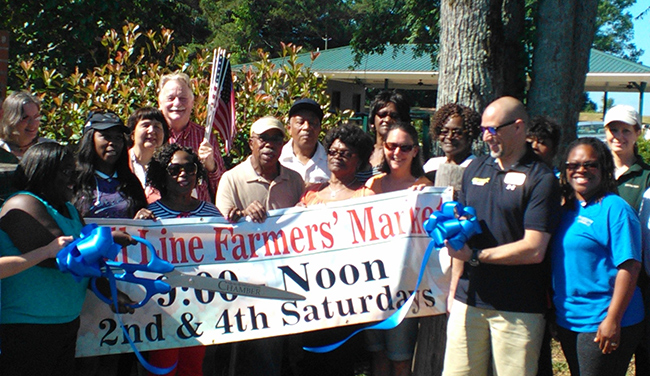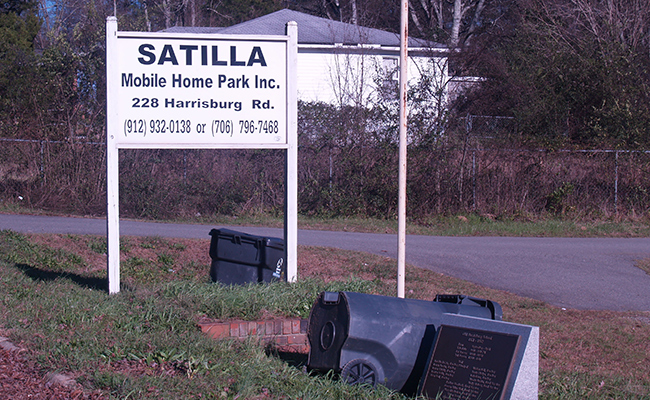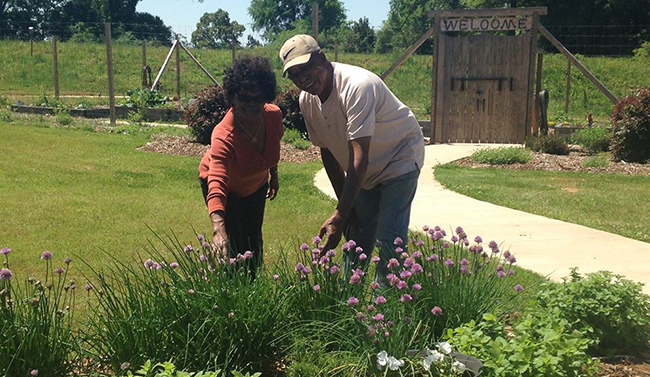Emerging from a Harsh Recession—A Community Regains Its Strength and Health through Collaboration
Print This Post
By Diana St. Lifer When Janet Cavin became the coordinator of Baldwin County Family Connection four years ago, she could never have imagined the national attention that would descend on the small Harrisburg neighborhood for its revitalization effort. Located just outside Milledgeville, Harrisburg—like much of Baldwin County—suffered the harsh effects of the recession, forcing state-funded organizations that had employed residents for generations to shut down. Among them was Central State Hospital, one of the oldest and largest psychiatric hospitals in the country. The hospital, along with several prisons and large manufacturing companies, closed its doors, sending many residents to the unemployment lines. “At one time people in Milledgeville could earn a high-school diploma and find a very good job making a nice income with benefits,” said Cavin. “Those jobs are gone and they’re not coming back. I don’t know if the community was prepared for what a 21st-century workforce would look like. It’s been devastating across the county.” Baldwin County was facing an unemployment rate of 16.5 percent in 2011, and Harrisburg, nearly 25 percent. It was around that time when Cavin joined Family Connection and saw firsthand how support programs for families were feeling the strain of a community in need.
“People who had been able to take care of themselves and their families were all of a sudden in need of food stamps and other assistance,” said Cavin. “The Oconee Regional Medical Center emergency room became overcrowded with people who didn’t have health insurance, and, other organizations like the Salvation Army saw an increase in the number of residents who needed assistance with bills and rent. These were people that these organizations had never seen before.” To make matters worse, Cavin realized that few people knew about the local Family Connection and its mission to collaborate with community partners to improve the lives of children and families. “Very little was happening when I first arrived at Baldwin County Family Connection,” Cavin recalled. “It turned out to be positive, though, because I knew we needed to do a community assessment.” Cavin spent nearly six months introducing herself to folks in the community and inviting them to monthly meetings to take a close look at the well-being of the children and families by exploring the KIDS COUNT data. That’s what led them to discuss low high-school graduation and high unemployment rates—two critical issues facing the county. The Collaborative partners decided to focus on the Harrisburg community, because that was an area with a high rate of poor school performance and unemployment. Conversations turned into planning, which got the wheels in motion to obtain grants and put those plans into action. “We have a community of partners who are willing to work together and share resources,” Cavin said. “That has made us attractive to investors.” Milledgeville is one of 26 Knight Communities in the country—locations where the Knight brothers owned newspapers—to receive funding from the Knight Foundation. Last year the Foundation awarded the Collaborative a $40,000 grant to assist in the revitalization efforts. “One of the ways they wanted to see the money used was for a neighborhood revitalization project, and of course at that point they are singing our song,” Cavin said, referring to the work in Harrisburg that gained the attention of Habitat for Humanity International (HFHI). Because of the project, Baldwin County became the site for one of three HFHI affiliate summits held earlier this year. What began with a small group of residents looking to create a community garden has evolved into an assembly of community partners exploring strategies to significantly improve the lives of residents and families over the next several years. Located on the grounds of an abandoned school building, part of which has been converted into a community center, the garden project took root and began to spread.
“Everyone who sees the garden has that same ‘Wow!’ reaction,” said Cavin. “A small project with 12 to 15 plots, has blossomed to more than 30 plots, plus a walking trail, orchard, and pavilion. We felt a real sense of accomplishment and pride when HFHI decided to have its summit here. To have people from communities in other states looking at what we’re doing and asking us for advice and suggestions validated that what we’re doing is vital, unique, and a model for the rest of the country.” In May 2015, community residents, officials, business and educational leaders and members of the Revitalization Coalition spent three days discussing plans to move forward. As a result, a 26-page Harrisburg Neighborhood Revitalization Strategy was drafted as a first step toward developing an action plan for Harrisburg’s Neighborhood Revitalization Strategy. The report outlines a vision for continued revitalization including potential projects that will improve education, lifestyle, economic development, housing, and culture in the historically rich neighborhood. The revitalization efforts taking place in Harrisburg are just a sample of the work being done in Baldwin to improve the lives of children and families throughout the county. “I spend a lot of time bringing people together,” said Cavin. “If I hear about an organization interested in taking on a particular issue and then hear the same thing from another organization in a different part of the county, I will make that connection. Because everything we do is aimed at improving conditions and prospects of every child and family in our community. We are—and always have been—working toward measurably better outcomes for everyone.” Diana St. Lifer is a professional writer with more than 25 years’ experience. She holds a bachelor’s degree in communications, a post-B.A. certificate in child advocacy, and is a certified professional life coach who specializes in teen and adolescent issues. More than 160 people from throughout the northeast had an opportunity to see how a once-thriving Baldwin County neighborhood that fell victim to the economic downfall has banned together in a revitalization effort that has gained national attention. Telling families about the importance of exercise and eating healthy is one thing; providing opportunities for them to engage in that behavior is another. Bridging that gap between understanding and opportunity was the motivation behind Live Healthy Baldwin. This program, which began with a youth summer health camp, has grown to include community gardens, farmers markets, walking and biking trails, and school-based programs to help fight the county’s obesity crisis. |


